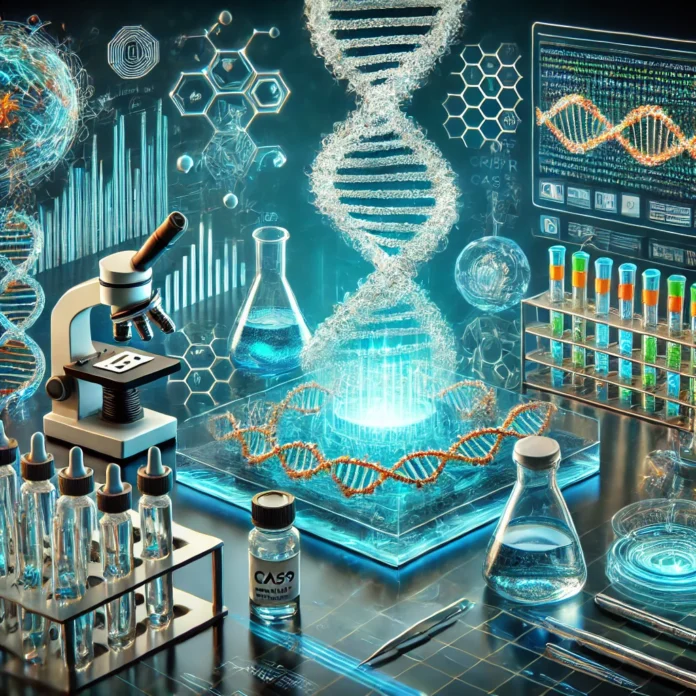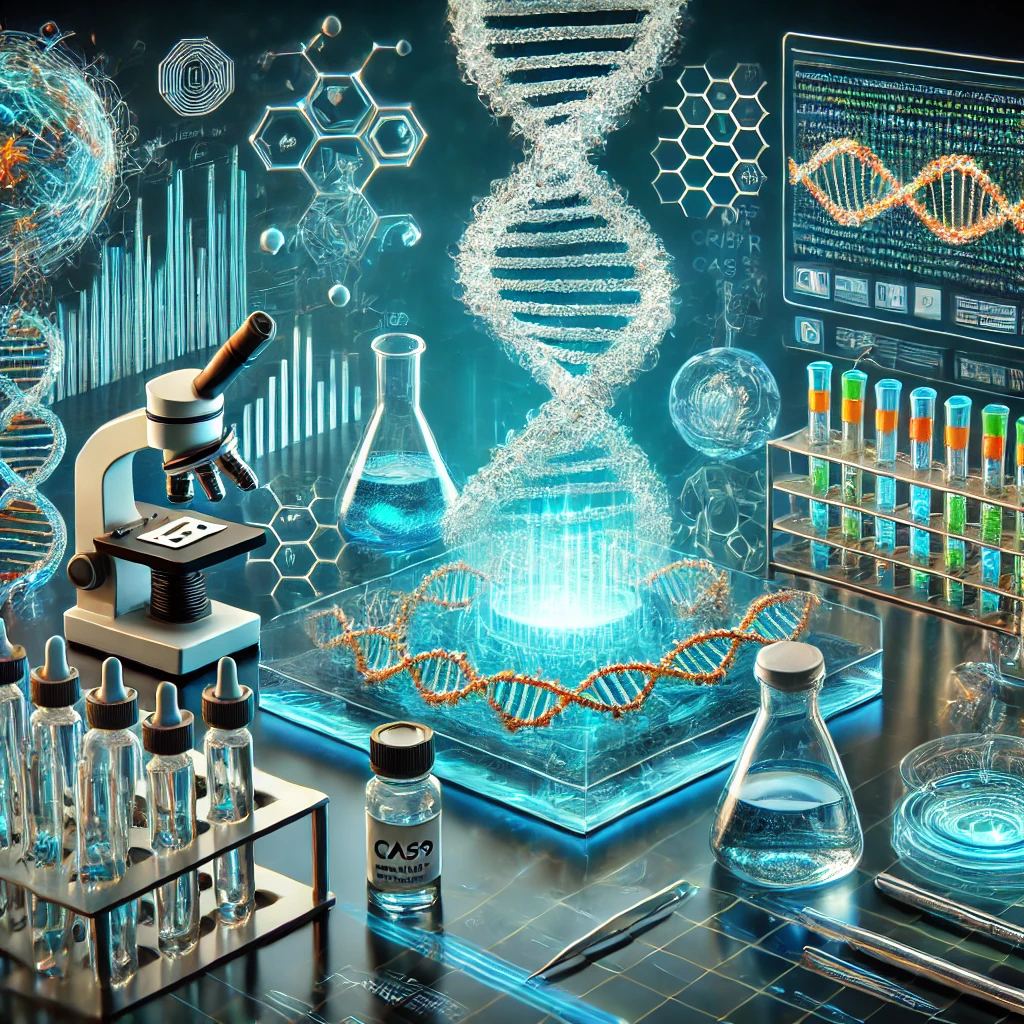
Biotechnology and gene editing represent one of the most groundbreaking advancements of the 21st century. With the development of tools like CRISPR-Cas9, researchers now have unprecedented ability to alter the genetic makeup of organisms, from humans to plants, with remarkable precision. This has enormous implications for medicine, agriculture, and the future of how we understand biology itself.
What is CRISPR and How Does It Work?

CRISPR (Clustered Regularly Interspaced Short Palindromic Repeats) is a gene-editing technology that allows scientists to modify DNA with high precision, efficiency, and ease. Discovered in bacteria as a natural defense mechanism against viruses, CRISPR functions as a tool to “cut and paste” sections of DNA.
The process uses two key components:
Cas9 enzyme: This acts as molecular scissors that cut the DNA at a specific site.
Guide RNA (gRNA): This sequence of RNA guides the Cas9 enzyme to the exact location in the genome that needs to be edited. Once the DNA is cut, the cell naturally repairs the break, and during this process, scientists can insert or delete specific genes.
The simplicity, affordability, and accuracy of CRISPR-Cas9 have revolutionized genetic research. Previously, gene editing was slow, expensive, and prone to errors. CRISPR changed that by offering a tool that was not only quicker and cheaper but also far more precise.
Other Gene-Editing Technologies
While CRISPR is the most well-known tool, it is not the only method available for gene editing. Other technologies have been developed to complement or improve upon the work done by CRISPR. Some of these include:
TALENs (Transcription Activator-Like Effector Nucleases): TALENs are proteins that can be engineered to bind to specific DNA sequences and cut them. Similar to CRISPR, TALENs have been used for precise gene editing but are more complex and labor-intensive to design than CRISPR.
Zinc Finger Nucleases (ZFNs): ZFNs are another type of molecular scissors used for gene editing. They work by binding to specific sequences of DNA, allowing for precise cuts. Although effective, ZFNs are more difficult to create for specific applications compared to CRISPR.
Base Editing and Prime Editing: These newer advancements in gene-editing technologies offer even more refined control. Base editing allows scientists to change a single DNA base pair without breaking the DNA strand, while prime editing is a more versatile version of CRISPR that can perform more precise edits without requiring the double-strand break that CRISPR typically induces.
Potential Impact on Medicine
Gene editing, especially CRISPR, holds immense promise for transforming medicine. The potential applications are numerous, ranging from treating genetic disorders to fighting cancer and infectious diseases.
1. Curing Genetic Diseases
Many human diseases are caused by mutations in a single gene. CRISPR offers the possibility of correcting these mutations at their source. For example, diseases like sickle cell anemia, cystic fibrosis, and muscular dystrophy are caused by single-gene mutations, making them ideal candidates for CRISPR-based therapies.
Clinical trials are already underway to test CRISPR treatments for some of these conditions. In 2020, researchers made headlines by using CRISPR to successfully treat patients with sickle cell disease and beta-thalassemia—two inherited blood disorders—by editing the stem cells that produce blood cells, offering hope for a cure.
2. Cancer Therapy
CRISPR is also being explored as a way to enhance cancer treatment. One area of research focuses on modifying immune cells to target and destroy cancer cells more effectively. By editing T cells (a type of immune cell), scientists can make them better at recognizing and attacking cancerous tumors. This type of therapy, known as CAR-T cell therapy, is already being used to treat certain cancers, and CRISPR could further improve its effectiveness.
3. Infectious Disease Control
CRISPR can be used to combat infectious diseases by targeting the genetic material of viruses. For instance, researchers have used CRISPR to cut out segments of DNA from viruses like HIV and hepatitis B, potentially offering a way to eradicate these diseases. There is also ongoing research to apply CRISPR in the fight against emerging diseases, such as COVID-19, by using the technology to detect or inhibit the virus’s replication.
4. Organ Transplants and Tissue Regeneration
Gene editing could also pave the way for advances in xenotransplantation—the transplantation of animal organs into humans. By editing the genes of animals like pigs, researchers can reduce the risk of organ rejection, potentially providing a new source of organs for transplantation. Additionally, gene-editing technologies are being used to improve stem cell therapies, which could be applied to regenerate damaged tissues or organs.
Impact on Agriculture
The application of gene editing in agriculture could revolutionize how we produce food, making crops more resilient and boosting productivity. Here are some potential impacts:
1. Creating Drought-Resistant and Pest-Resistant Crops
One of the most pressing challenges in agriculture today is climate change, which leads to more frequent and severe droughts, flooding, and other extreme weather conditions. Gene-editing technologies like CRISPR can be used to create crops that are more resistant to environmental stresses, helping to ensure food security in a changing climate. By altering the genes responsible for water usage or heat tolerance, crops like corn, wheat, and rice could be made to thrive in harsher conditions.
Similarly, CRISPR can be used to develop pest-resistant crops. Traditionally, farmers have relied on pesticides to protect crops from pests, but gene-editing could provide an alternative by making crops more resilient to insects and diseases. For example, researchers have used CRISPR to modify tomatoes and soybeans to resist common plant viruses, potentially reducing the need for chemical pesticides.
2. Improving Nutritional Content
Gene editing can also enhance the nutritional value of food. CRISPR has already been used to biofortify crops by increasing their content of essential nutrients like vitamins and minerals. This could be particularly beneficial in regions where malnutrition is prevalent. For instance, CRISPR could be used to boost the vitamin A content in rice, addressing the problem of vitamin A deficiency in many developing countries.
3. Reducing Food Waste
CRISPR could help tackle food waste by extending the shelf life of perishable goods. Researchers have already used the technology to modify mushrooms to prevent them from browning, which could reduce the amount of food discarded due to spoilage. Similar modifications could be applied to other fruits and vegetables to keep them fresh for longer periods.
Ethical Considerations and Challenges
While the potential of gene editing is vast, it also raises significant ethical concerns.
1. Designer Babies and Genetic Enhancements
One of the most controversial aspects of CRISPR is its potential use in human germline editing—the modification of embryos in a way that would affect future generations. In 2018, a Chinese scientist claimed to have used CRISPR to edit the genes of human embryos, sparking global outrage. This raised fears about the prospect of “designer babies,” where parents could choose their children’s traits, from physical appearance to intelligence.
While germline editing could potentially eliminate genetic diseases, it also opens the door to serious ethical questions about consent, inequality, and unintended consequences.
2. Off-Target Effects
Although CRISPR is highly precise, there is still the possibility of off-target effects, where unintended parts of the genome are edited. These unintended changes could have harmful consequences, such as increasing the risk of cancer or causing genetic mutations that affect future generations.
3. Gene Editing in Agriculture and Biodiversity
Gene editing in agriculture also raises concerns about its impact on biodiversity. While creating pest-resistant crops or increasing yields can provide significant benefits, it could also lead to a reduction in genetic diversity, making ecosystems more vulnerable to disease outbreaks or environmental changes.












































